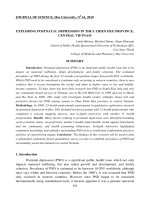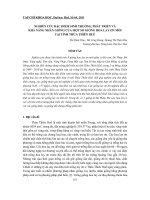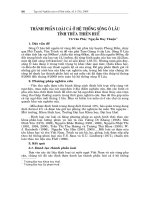Báo cáo nghiên cứu khoa học: "Nghiên cứu về bệnh trầm cảm sau khi sinh tại tỉnh Thừa Thiên Huế, miền Trung Việt Nam." potx
Bạn đang xem bản rút gọn của tài liệu. Xem và tải ngay bản đầy đủ của tài liệu tại đây (450.36 KB, 10 trang )
303
JOURNAL OF SCIENCE, Hue University, N
0
61, 2010
EXPLORING POSTNATAL DEPRESSION IN THUA THIEN HUE PROVINCE,
CENTRAL VIETNAM
Linda Murray, Michael Dunne, Nigar Khawaja
School of Public Health,
Queensland University of Technology (QU)
Cao Ngoc Thanh
College of Medicine and Pharmacy, Hue University
SUMMARY
Introduction: Postnatal depression (PND) is an important public health issue due to its
impact on maternal wellbeing, infant development, and family cohesion. The estimated
prevalence of PND during the first 12 months post-partum ranges between10-20% worldwide.
Whilst PND used to be considered a syndrome only occurring in western countries, there is now
evidence that it occurs throughout the world, and often at higher rates in low and middle-
income countries. To date, there has been little research into PND in South East Asia and only
two community-based surveys in Vietnam, one in Ho Chi Minh City in 1999 and one in Hanoi
and Ha Nam in 2009. This study will investigate health worker attitudes about risk and
protective factors for PND among women in Thua Thien Hue province in central Vietnam.
Methodology: In 2009, 23 health professionals participated in qualitative exploratory research
of postnatal depression in Hue. This included two focus groups with 12 health professionals who
completed a concept mapping process, and in-depth interviews with another 11 health
professionals. Results: Many factors relating to postnatal depression were identified including
socio-economic status, son preference, mother’s health, infant health, social support from family
and the community, and health promoting behaviours. In-depth interviews highlighted
community knowledge and attitudes surrounding PND such as traditional confinement practices
and fear of experiencing stigma. Conclusion: The findings of this research will be used to plan
a substantial community-based quantitative survey in order to establish prevalence of PND and
surrounding social determinants in central Vietnam.
1. Introduction
Postnatal depression (PND) is a significant public health issue which not only
impacts maternal wellbeing, but also infant growth and development, and family
cohesion. Prevalence of PND is estimated to be between 10-20% worldwide, although
rates vary within and between countries. Before the 1980’s, it was assumed that PND
only occurred in western countries. However once PND began to be measured
internationally using standardised tools, it became apparent it was a genuine universal
304
disorder showing similar symptoms across cultures. Emerging evidence suggests the
prevalence of PND may be higher in low and middle income countries than in high
income countries, and carry considerable social and economic consequences. However
less than 10% of low and middle income countries have data available.
Socio-cultural factors are very influential in the aetiology and progression of
perinatal mental health disorders. Social risk factors of PND identified in Hong Kong,
China, Singapore and Thailand include unwanted pregnancy, intimate partner violence,
relationships with extended family (particularly in-laws), maternal self esteem, infant
temperament and socio-economic status. Son preference is cited as an influential factor
of PND in China, Hong-Kong, Taiwan and Korea. In mainland China, mothers who
gave birth to a girl are twice as likely to suffer from PND. A study of 252 postpartum
women in Goa, India, also found that the risk of PND following disappointment about
the infant’s gender had an odds ratio of 3.3 (p = 0.002). In Vietnam, son preference has
not been studied in relation to PND. However Pham et al (2008) state that the national
reproductive health policy can create pressure to have a son within two births.
Studies of perinatal mental health have been conducted in both the north and
south of Vietnam. In a sample of 506 women in HCMC, 33% of women were found to
have PND, and 19% of participants acknowledged thinking about suicide. In the north
of Vietnam, a study of 364 postpartum women from Hanoi and Ha Nam province found
that 29.9% had a common mental disorders (CMD) and that CMD were more common
in rural areas. Other studies have found that 20% of mothers of one year olds had
anxiety or depression in Vietnam, and that between 8 and 16.9% of recorded perinatal
deaths could be attributed to suicide. There is currently no data on PND from central
Vietnam. The purpose of this research is to identify risk and protective factors that
health professionals in Thua Thien Hue, Vietnam, perceived to be related to PND in
order to plan for a larger epidemiological study of maternal mental health in the area.
2. Methodology
Methodological Approach: The theoretical approach of this research project
was community based participatory research (CBPR). CBPR aims to draw on multiple
sources of expertise when deciding what health risks matter, what causes them and what
can be done about them. In social epidemiology, CBPR is used to increase the rigor of
descriptive research through identifying social determinants of health through
collaboration with local stakeholders
Study Site: This study was conducted in Thua Thien Hue province in Central
Vietnam in collaboration with Hue University of Medicine and Pharmacy.
Participants: For the focus groups, a purposive sample of twelve maternal and
child health professionals were recruited from three commune health centres within
10km of Hue city, and one Provincial hospital. Nine midwives with 2-32 years
305
experience, and three doctors with 15-18 years experience participated in 2 two-hour
sessions. Another eleven experts in maternal health and mental health such as
Obstetricians and Psychiatrists participated in in-depth interviews.
Ethics: This study has ethical approval from both Queensland University of
Technology and Hue University of Medicine and Pharmacy.
Methods: In-depth interviews lasted 40-60 minutes and were recorder on an
MP3 player with the interviewee’s permission. If the interviewer did not wish to be
recorded the researcher took detailed notes. Interviews were either conducted in English
or translated simultaneously. The interview transcripts were then analysed into themes
using NVivo 8 software.
For the focus groups, a concept mapping process developed by Trochim (1989)
was used. Trochim’s concept mapping is a structured group process which both
describes concepts as well as quantifying the strength of conceptual relationships. The
focus groups were conducted by two Vietnamese facilitators, who translated materials
into English at the end of the workshops. At the end of the concept mapping process, the
results are visually represented as concept ‘maps’ using ‘Concept Systems’ software.
Trochim concept mapping uses the following steps:
Brainstorming: Participants were given a definition of postnatal depression
and it’s common symptoms, and asked to think of any factors they thought
might be related to it, whether positive or negative.
Sorting: Each participant then received a packet of the statements printed on
cards, and were asked to sort them into piles ‘in a way that made sense to
them.’ The rules were that each card could only be used once, and to make
more than one pile. Once they had finished the individual sorted piles were
collected and entered into Concept Systems software for analysis.
Rating: Each participant was then asked to rate each statement from 1 ‘least
likely’ to 5 ‘most likely’ according to the following headings: ‘likely to cause
PND’ and ‘likely to protect against PND.’ This information was also
analysed with Concept Systems software.
Verification: Once the information was analysed, the groups then met again
to look at the concept maps and decide if they accurately reflected their
previous work.
3. Results
3.1. Brainstorming: Participants brainstormed 46 statements to include in the
sorting and rating activities. A list of the statements is outlined in figure one.
3.2. Sorting: From the sorting exercise, a concept map was produced (see figure
306
two). Each of the 46 statements is located as a point on the map. Statements that were
sorted together more frequently appear closer to each other on the map and represent
similar themes than statements more distant from them. The statements fitted naturally
into eight thematic clusters, which are enclosed by the polygons on the map.
3.3. Rating: The next two maps show how the eight clusters were rated by
participants as ‘most likely to cause PND,’ and ‘most likely to protect against PND.’
The rating map depicts the relative average rating on a 5 point likert scale (where 1 =
least likely, 5 = most likely) in relation to being likely to cause PND. The number of
layers represents how strongly participants rated a statement as being likely to cause
PND. The more layers there are, the more participants rated statements in this cluster as
likely to cause PND. The layers represent a double averaging – across all participants
and all of the statements in each cluster.
Figure three clearly shows that the clusters ‘negative stressors,’ and ‘mother’s
emotions and worry’ were rated as highly likely to be risk factors for PND with average
ratings of 3.73 to 4.24. ‘Mother’s health’ and ‘baby’s health’ were also considered to be
risk factors with average ratings of 3.23 to 3.75, but were not rated as highly as the
previous two clusters. ‘Economics’ had an average rating of 2.73 to 3.23, which means
it was not considered as influential as other social and health factors in causing PND.
Figure four represents statements participants perceived as most likely to protect
against PND. Economics was moderately rated as a protective statement (average rating
of 2.72 to 3.08), although it should be noted participants put positive as well as negative
statements about economics in this category. Interestingly, ‘family aspects’ and ‘society
and friendship’ (average 3.82 to 4.91) were rated more likely to be protective than
factors explicitly categorised and labelled in focus groups as ‘protective factors.’ The
statements in the ‘protective factors’ cluster were mainly about individual health
behaviours such as exercise and rest, whereas ‘family aspects’ and ‘society and
friendship’ all describe personal relationships and connections.
3.4. Interpretation of Maps
In the second focus group, participants were shown the maps and decided if they
considered the clusters generated to be meaningful. Both groups agreed that statement
16 ‘sleeplessness because of the baby’ should be moved to the cluster ‘Mother’s Health’.
The group of 6 midwives thought that husbands needed a category of their own, apart
from other family aspect, however it was decided overall that this wouldn’t be changed.
In general, both groups thought the maps represented their ideas accurately.
3.5. In – depth interviews
In-depth interviews provided more depth to many of the themes discussed in the
focus group, including themes of son preference and also stigma about accessing mental
307
health services. The quote below explains women’s reluctance to access health services:
“They don’t come to the hospital except for the serious case, the reason is they
don’t want to meet with the psychiatrist because sometimes the depression in women
makes them not want to take care of the baby and if they go to the psychiatrist, maybe
they, the psychiatrist will say they are lazy or that they don’t love the baby.”
One of the interviews provided the following vignette about a woman suffering
from possible PND in relation to son preference:
Interviewee: She has a patient, a woman who is a teacher, she had the first baby
but unfortunately she is a girl, so after delivery she calls this postnatal depression
because the woman don’t like to contact with other people, she just lies, the back of hers
to the baby and doesn’t want to eat, she didn’t want to eat and didn’t want to talk to
other people, because of the gender… Because when she was pregnant and she took an
ultrasound and the doctor said that this was a boy and the husband was very hopeful,
but after delivery the baby was a girl so the husband was a little bit disappointed and it
makes the woman feel bad.
4. Discussion
Overall, the concept mapping exercise allowed participants to identify risk and
protective factors of PND both individually and as a group. Participants naturally sorted
the statements into eight clusters, some which were previously in the literature on PND
such as maternal health, infant health, social relationships, economics and family
relationships. Interestingly, some of the statements that emerged are not previously
identified in the literature such as ‘good atmosphere,’ ‘worry about beauty and physical
appearance,’ ‘enough rest, sleeping late,’ ‘the grandparents not accepting the child and
sending it to an orphanage’ and statements regarding son preference. The fact infant
gender was mentioned in five separate statements highlights its importance. This is
congruent in other literature from Asia but is yet to be explored in - depth in. Other
statements in the ‘emotion and psychology’ cluster such as ‘physical appearance,’ ‘low
self esteem within the community,’ and ‘gender of the baby the husband didn’t want’
have also not been explored in relation to each other before.
Mother’s health, baby’s health and economics are routinely mentioned in the
literature about PND from other countries, but were not considered as important as
categories including social support. Rating social factors more highly than economics as
a risk factor for PND is also consistent with the literature on risk factors for PND in
developing countries. Vietnamese mothers have very high levels of social support, with
one study showing 85% of mothers received support from two or more sources. Strong
social support positively affects maternal coping, child nutritional status and cognitive
development. The benefits of supportive nurturing family relationships can override
even severe economic adversity in protecting against common perintatal mental
308
disorders.
In-depth interviews added depth to the themes mentioned above. They also
highlighted that many women suffering mental health issues in Hue were unlikely to
seek treatment due to little knowledge about PND or fear of experiencing stigma. It is
internationally recognised that large proportions of people suffering from common
mental disorders in low and middle income countries receive no treatment due to
underuse of, and poor access to health services and stigma In a study of maternal
mental health in northern Vietnam, none of the women diagnosed with a CMD had ever
received mental health care.
Limitations of this method include the fact it requires resources that may not be
easy to attain such as proprietary software One major limitation of the method’s
accessibility is that Concept Systems is yet to be available with fonts for other
languages. Also, as this is a qualitative method, the results are not generalisable, but are
only representative of the ideas of the group that participated. Hence the results are
useful for planning further studies but not identifying social determinants at a
population level.
5. Conclusion
Overall, this exploratory research was useful in identifying health professional’s
perspectives about the social determinants likely to influence PND in Hue. The concepts
resulting from this research will be used to inform a larger quantitative epidemiological
study of social determinants of PND in Hue in 2010.
REFERENCES
1. Beck, C. T., & Driscoll, J. W. Postpartum mood and anxiety disorders: A clinician's
guide. Massachusetts: Jones and Bartlett Publishers, (2006).
2. Chien, L., Tai, C., Ko, Y., Huang, C., & Sheu, S Adherence to "doing-the-month"
practices is associated with fewer physical and depressive symptoms among postpartum
women in Taiwan. Research in Nursing & Health, 29(5), (2006), 374-383.
3. Das, J., Do, Q. T., Friedman, J., & McKenzie, D Mental health patterns and
consequences: Results from survey data in five developing countries. The World Bank
Economic Review, (2008), 1-25.
4. De Silva, M. J., Huttly, S. R., Harpham, T., & Kenward, M. G. Social capital and
mental health: A comparative analysis of four low income countries. Social Science &
Medicine, 64(1), (2007), 5-20.
5. Fisher, J. R. W., Tran, T., Buoi, L. T., Rosenthal, D., Kriitmaa, K., & Tuan, T Common
309
perinatal mental disorders in women in the north of Vietnam: Community prevalence
and interaction with health care use. Bulletin of the World Health Organsation, In
Press, (2010).
6. Gupta, M. D., Zenghua, J., Bohua, X. Z. L., & Chung, B. H. W. (2003). Why is son
preference so persistent in east and south asia? A cross-country study of China, India
and the Republic of Korea. World Bank Policy Research Working Paper no.2942. The
World Bank. Retrieved 29 November 2009, from
7. Harpham, T., & Tuan, T. . From research evidence to policy: mental health care in
Vietnam. Bulletin of the World Health Organization, 84(8), (2006), 664-668.
8. Kane, M., & Trochim, W. M. K Concept Mapping for Planning and Evaluation.
Thousand Oaks: SAGE, (2007).
9. Kleinman, A Global mental health: a failure of humanity. The Lancet, 374, (9690),
(2009), 603-604
10. Wong, J., & Fisher, J The role of traditional confinement practices in determining
postpartum depression in women in Chinese cultures: A systematic review of the
English language evidence. Journal of Affective Disorders, 116(3), (2009), 161-169.
Figure One
Cluster Statements
Economics 2 Worry about losing employment (applies to professionals)
11 Lost opportunities for promotion (e.g after third child)
1 Economic difficulty
9 Loss of income post delivery
10 Sufficient financial resources
4 Less time for social activities
Family Aspects 25 Informational support from relatives and family
44 Happy/harmonious family
21 Supportive husband
22 Gender of the baby is the one they desired
Society and
Friendship
26 Support from the reproductive health program
40 Good atmosphere
43 Help of the neighbourhood
46 Support from mother’s friends
Mother’s emotions 34 Single mother
310
and worry
31 Husband very concerned about the gender of the baby
5 Gender of the baby the parents don’t want
33 Gender of the baby the mother didn’t want
39 Disappointment because the gender is different to the
ultrasound
10 Lack of confidence about their place in the community
(e.g after third child)
3 Worry about physical appearance after delivery
Negative Stressors 14 Husband isn’t loyal
38 Grandparents don’t accept the baby and send it to an
orphanage
30 Husband is rude, drinks, and goes out a lot
13 Lack of care, concern and help from relatives
35 A family member has recently died
45The family observes traditional customs the mother
doesn’t want to follow
Baby’s Health 6 Stillbirth
15 The baby has a congenital disability
18 Poor health of the baby
32 Baby difficult to nurse
17 Worry about enough milk for the baby
42 Healthy baby
24 The baby is feeding well
Mother’s Health 19 The mother has a history of mental illness
8 Obstetric complications (e.g postpartum haemorrhage)
37 Caesarean wound infection
12 Other physical disease during pregnancy and delivery
36 Pain and fatigue after delivery
7 Pain during delivery
Protective Factors 16 Sleeplessness due to the baby
28 Regular diet
29 Sufficient relaxation, wakes up late
311
27 Physical activity for avoiding stress
41 Mother doesn’t smoke or drink coffee or alcohol
23 The mother has enough time to take care of the baby
Figure 2
Figure 3
312
Figure 4









